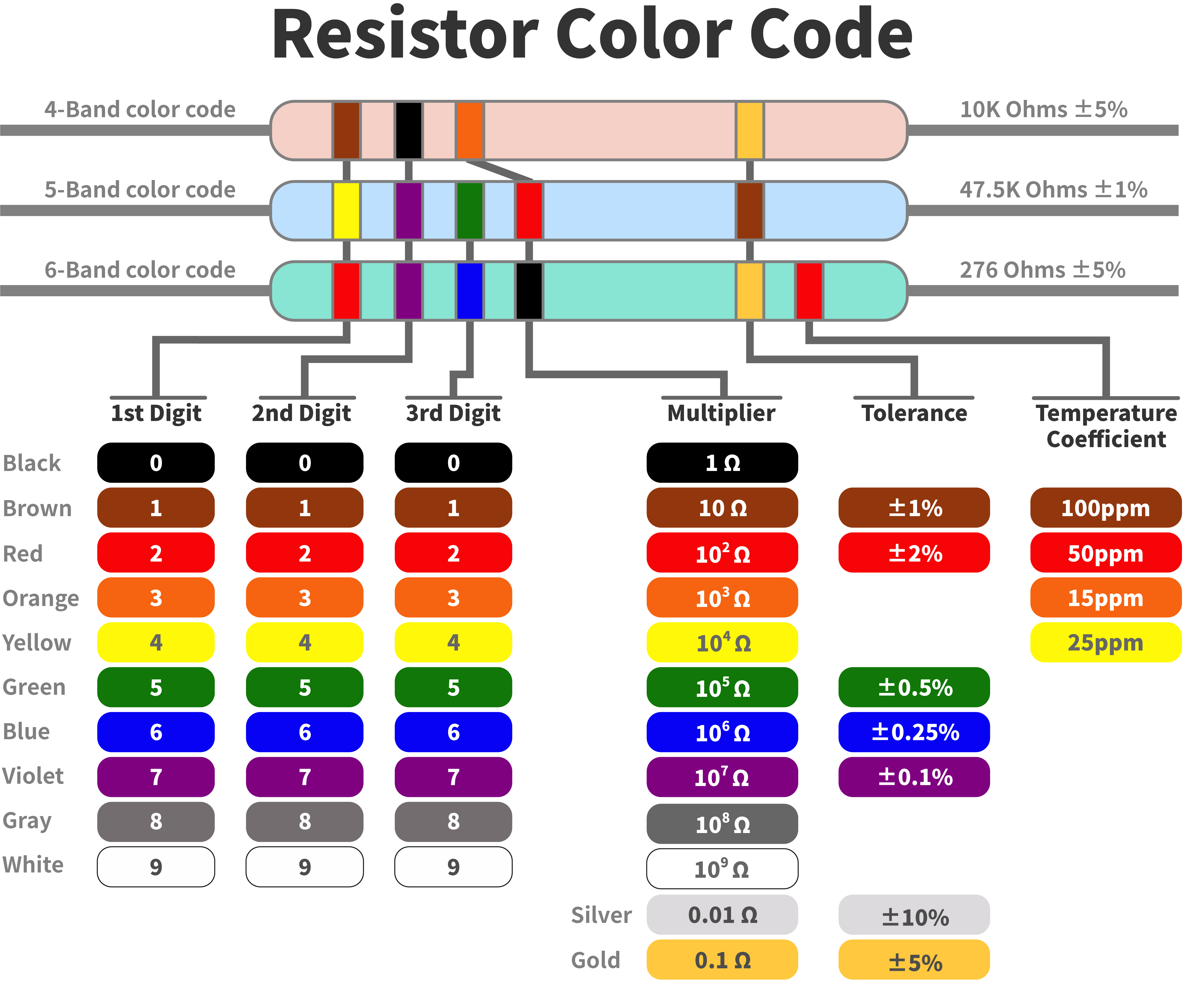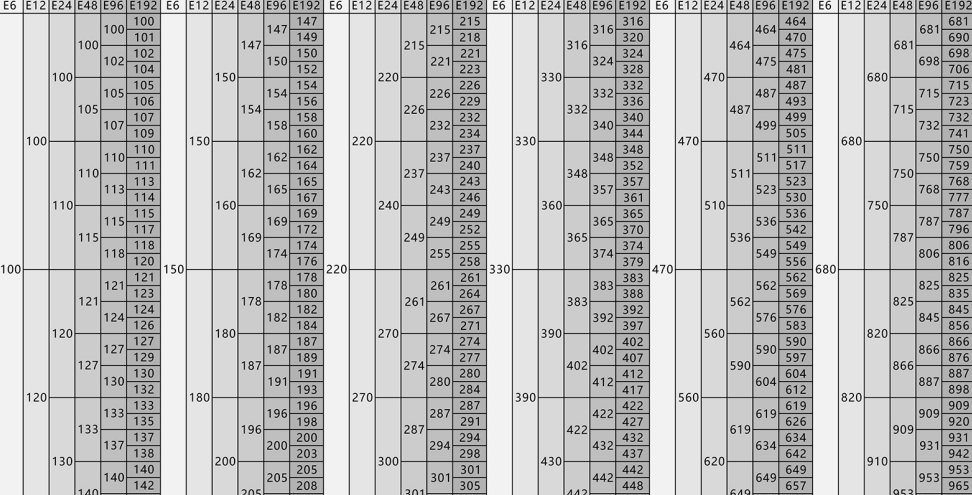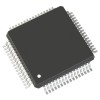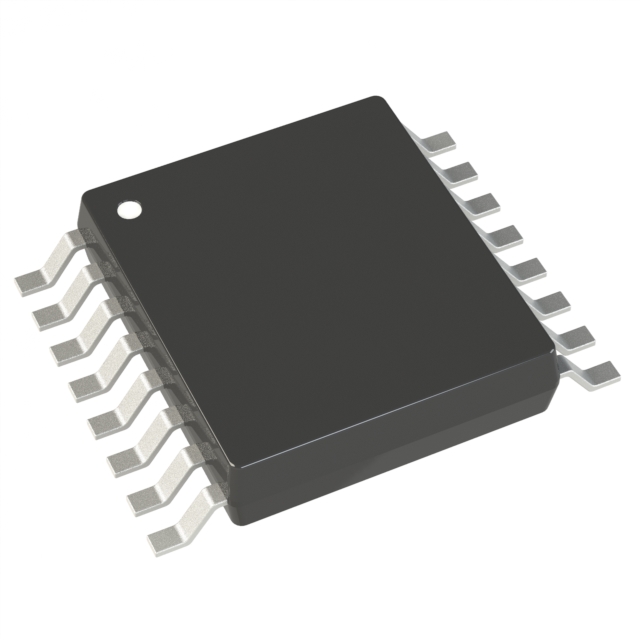| 如何读取电阻器颜色 |
| 什么是电阻器? |
| 读取电阻器颜色注释 |
| 全系列电阻值表 |
| 电阻器的种类 |
| 电阻器符号 |
| 标准 EIA 十进制电阻器值 |
| 常用电阻器的颜色代码 |
- 原创内容,请勿转载
如何读取电阻器颜色
• 电阻器中的颜色包含有关电阻的大部分信息,其中包括电阻值、容差、乘数甚至温度系数,每种颜色代表一个数字,每个数字都是参数的一部分。当我们知道了这一点,就不要急于了解了,我们发现颜色环电阻上面的环数是不同的,有的多有少,事实很简单,通常有4波段、5波段、6波段三种标记方式,所以我们只需要弄清楚留下来的两样东西是什么,是最简单的部分。
• 如电阻色码表所示,网上有一些方法为了让人们记住这些颜色代表上面的数字,但实际上,您不需要浪费这个想法。我们只需要把它放到阻力控制表中,练习几次,这样你就很容易找出你的阻力参数。
• 它分为4 5 6波段四种颜色的环形电阻,4波段电阻通常是比较普通的电阻,5波段电阻器大多是高精度的,而6波段电阻器则大多是高精度的。为了方便大家理解,我们应该从最后一个环开始解释,通常是 tolerance,倒数第二个是 multiplier。
• 接下来,我们可以使用电阻器颜色代码图来识别它。从 4 BAND 开始:棕色是 1 黑色是 0 橙色是 3 表示是 10 ³ = 10000 欧姆这里我们得到基本单位 OHM,电阻的基本单位是:欧姆 (Ω)、千欧姆 (KΩ)、万亿欧姆 (M Ω).1000 欧姆 (Ω) =1 千欧姆 (KΩ),1000 千欧姆 (KΩ) =1 兆欧 (MΩ),一次可以转换为 10K, 这样我们得到电阻值,那么最后一个环是金的容忍度对应 5%。
• 当你识别出一个 4 波段时,你可以尝试识别一个 5 波段以增强你的识别能力,(电阻色码表)中 5 波段的第一行是黄色 =4 紫色 =7 绿色 = 5 红色对应乘数 10^2=100 的二次方,得到 475 * 100=47500 Ω / 1000=47.5k,最后一个波段是橙色 1% 来识别它的型号是 47。5K 1%,那么 6band 部分的色带与 4band 5band 是它有一个频带温度系数,这个图表中的温度系数是棕色的,即 100ppm,如果你能进一步了解电阻的温度系数 - 意思是,这也是我们在设计选择中理解电阻跟踪的一个非常重要的步骤。

什么是电阻器?
电阻器是一种限流元件,是一种调节或限制电流的电子元件,它可以限制通过它所连接的分支的电流。简单来说,它就像一根细小的分流管,可以调节控制电流的大小,也可以了解电阻器的工作原理,可以帮助您更深入地了解它。
阅读电阻器颜色注释
当我们计算电阻颜色代码时,有些人可能会混淆最后两个频段,出现公差和乘数或温度系数,错误将其识别为乘数,如果您不想造成麻烦,您也可以使用我们的电阻器颜色代码计算器工具,您可以更轻松地识别您的电阻器。
全系列电阻值表
| Full series of resistance value table | ||||||||||||||||
| 1Ω | 1.1Ω | 1.2Ω | 1.3Ω | 1.5Ω | 1.6Ω | 1.8Ω | 2.0Ω | 2.2Ω | 2.4Ω | 2.7Ω | 3.0Ω | 3.3Ω | 3.6Ω | 3.9Ω | 4.3Ω | 4.7Ω |
| 5.1Ω | 5.6Ω | 6.2Ω | 6.8Ω | 7.5Ω | 8.2Ω | 9.1Ω | 10Ω | 11Ω | 12Ω | 13Ω | 15Ω | 16Ω | 18Ω | 20Ω | 22Ω | 24Ω |
| 27Ω | 30Ω | 33Ω | 36Ω | 39Ω | 43Ω | 47Ω | 51Ω | 56Ω | 62Ω | 68Ω | 75Ω | 82Ω | 91Ω | 100Ω | 110Ω | 120Ω |
| 330Ω | 150Ω | 160Ω | 180Ω | 200Ω | 220Ω | 240Ω | 270Ω | 300Ω | 330Ω | 360Ω | 390Ω | 430Ω | 470Ω | 510Ω | 560Ω | 620Ω |
| 3.6k | 3.9k | 4.3k | 4.7k | 5.1k | 5.6k | 6.2k | 6.8k | 7.5k | 8.2k | 9.1k | 10k | 11k | 12k | 13k | 15k | 16k |
| 18k | 20k | 22k | 24k | 27k | 30k | 33k | 36k | 39k | 43k | 47k | 51k | 56k | 62k | 68k | 75k | 82k |
| 91k | 100k | 110k | 120k | 130k | 150k | 160k | 180k | 200k | 220k | 240k | 270k | 300k | 330k | 360k | 390k | 430k |
| 470k | 510k | 560k | 620k | 680k | 750k | 820k | 910k | 1M | 1.1M | 1.2M | 1.3M | 1.5M | 1.6M | 1.8M | 2.0M | 2.2M |
| 2.4M | 2.7M | 3.0M | 3.3M | 3.6M | 3.9M | 4.3M | 4.7M | 5.1M | 5.6M | 6.2M | 6.8M | 7.5M | 8.2M | 9.1M | 10M | 22M |
| power:1/4W 1/2W 1W 2W 3W | ||||||||||||||||
Types of resistor
• Although there are all kinds of resistances, but there are two kinds of resistances: linear and fixed, so what is the difference between linear resistor and fixed resistor? What are the differences between the different resistances? If the use of resistance needs to master more detailed words, you need to understand these, otherwise you only need to understand the mainstream resistor has its use.
• Ordinary resistance is one of the most basic resistors, which limits the current and reduces the pressure by generating the resistance in the circuit. The choice of ordinary resistance materials is very rich, common carbon film resistance, film resistance, metal film resistance, etc., these resistance types are widely used, widely used in communication, digital, power supply and other industrial fields.
• Compared with the ordinary resistance, the adjustable resistance can realize the adjustment of the resistance value, which is used to control the voltage and current of the circuit, and realize the control and debugging of the interconnected circuit. The types of adjustable resistance include variable resistance, mutation resistance and retaining resistance, applied to control and measurement systems in medical, automotive and aerospace fields.
• Heat dissipation resistance is one of the resistors widely used resistors in recent years. By improving the heat dissipation ability of the resistance body, it realizes the distribution and control of heat and ensures the normal work of the resistance current. The types of heat dissipation resistance include metal film heat dissipation resistance, aluminum shell resistance, porcelain heat dissipation resistance, etc., which are widely used in LED lighting, high power transmission and other fields.
• Resistance as one of the basic electronic components, it is a necessity of technology products, so its use is everywhere, everywhere in every corner of our life and work.
Resistor symbol
• Familiarity with the shape of the resistance can not only help us to draw the circuit diagram more efficiently, but also help us to have a deeper understanding of the resistor, of course, this is just the beginning, for any designer, to understand Electrical and Electronics Symbols and Meanings, is the systematic knowledge of assisting the work.
![1727085410929410.png 5C}N1W48M3R2C6P[GBBU1]T.png](/image/ueditor/php/upload/image/20240923/1727085410929410.png)
• Here contains resistor with capacitor common symbol, resistors, usually abbreviated as "R", in addition to all kinds of resistor symbol it also has a different identification, read them in the circuit, such as: fixed resistor usually with the most simple resistance form symbol, symbol at the ends of the resistance connection pin, very intuitive to understand.
• The symbol of the variable resistor then uses an arrow to mark its adjustable meaning.
• Once you understand the imagination of each symbol designer, you can easily write down these symbols, which may need a more detailed resistor symbol to get a more comprehensive understanding of these.
Standard EIA Decade Resistor Values
• The International Electrotechnical Commission (IEC) was published in 1952 as the international standard, namely the resistance E series resistance value. E indicates the exponential spacing, a sequence consisting of a geometric series.
• The nominal resistance value of the resistance is divided into six series, E6, E12, E24, E48, E96 and E192, which are applicable to the resistors with allowable deviation of 20%, ± 10%, ± 5%, ± 2%, ± 1% and ± 0.5%, respectively.Among them, E24 series is commonly used series, E48, E96 and E192 series are high precision resistance series.
• Nominal resistance value of E6 series resistance, corresponding to the allowable deviation of ± 20%, view the E6 series resistance control table.
• Nominal resistance value of E6 series resistance, corresponding to the allowable deviation of ± 20%, view the E6 series resistance control table.
• Nominal resistance value of E24 series resistance, corresponding to the allowable deviation of ± 5%, view the E24 series resistance control table.
• Nominal resistance value of E48 series resistance, corresponding to the allowable deviation of ± 2%, view the E48 series resistance control table.
• Nominal resistance value of E96 series resistance, corresponding to the allowable deviation of ± 1%, view the E96 series resistance control table.
• Nominal resistance value of E192 series resistance, corresponding to the allowable deviation of ± 0.5%, ± 0.25%, ± 0.1%. See the specification table of E192 series resistance.

From these we can see that the biggest difference between the different series is the allowable deviation, and we all know that the lower the deviation the higher the value of the resistor, and E192 is the lowest deviation. The higher the deviation the lower the resistance value, which can be interpreted as, since the range of deviation takes up quite a bit of resistance value space, the lower the deviation the more resistance values you can choose.
In conventional applications, the permissible deviation for most selections is E24±5% This is commonly used. The model numbers are also roughly these.
The color code of the common resistors
| Related Content: |
 Temperature Coefficient of Resistance - Meaning and calculate Temperature Coefficient of Resistance - Meaning and calculate |









